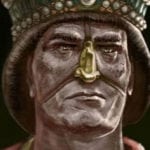 Mysteries
Mysteries  Mysteries
Mysteries  History
History 10 Surprising Stories About the Texas Rangers
 Humans
Humans 10 Philosophers Who Were Driven Mad by Their Own Theories
 Miscellaneous
Miscellaneous 10 Video-Game-Worthy Weapons and Armors from History
 Weird Stuff
Weird Stuff 10 Psychics Who Accurately Predicted Wartime Events
 The Arts
The Arts 10 Pieces of Art Inspired by a Broken Heart
 Health
Health 10 Science Fiction-Sounding New Medical Treatments
 History
History 10 Surprising Facts About the Father of Submarine Warfare
 Space
Space Ten Astonishing New Insights into Alien Worlds
 Weird Stuff
Weird Stuff 10 Bizarre Summer Solstice Rituals Still Practiced Today
 Mysteries
Mysteries Top 10 Haunting Facts About the Ghost Ship MV Alta
 History
History 10 Surprising Stories About the Texas Rangers
 Humans
Humans 10 Philosophers Who Were Driven Mad by Their Own Theories
Who's Behind Listverse?

Jamie Frater
Head Editor
Jamie founded Listverse due to an insatiable desire to share fascinating, obscure, and bizarre facts. He has been a guest speaker on numerous national radio and television stations and is a five time published author.
More About Us Miscellaneous
Miscellaneous 10 Video-Game-Worthy Weapons and Armors from History
 Weird Stuff
Weird Stuff 10 Psychics Who Accurately Predicted Wartime Events
 The Arts
The Arts 10 Pieces of Art Inspired by a Broken Heart
 Health
Health 10 Science Fiction-Sounding New Medical Treatments
 History
History 10 Surprising Facts About the Father of Submarine Warfare
 Space
Space Ten Astonishing New Insights into Alien Worlds
 Weird Stuff
Weird Stuff 10 Bizarre Summer Solstice Rituals Still Practiced Today
10 Bizarre Ways That Historical Royals and Nobles Have Died
Being royalty or nobility comes with a lot of obvious perks, such as money and power, but there is no escaping death. In the past, being a monarch or leader sometimes meant meeting a violent end, whether that was on the battlefield or through assassination. However, there are also a number of more unusual and bizarre ways that have taken out high-ranking historical figures.
Historical records from the past cannot always be taken as absolute fact, so a few of these deaths may have been exaggerated, but they are interesting nonetheless. So, here are 10 of the weirdest ways that royals and nobles have reportedly left this mortal world.
Related: Top 10 Embarrassing Incidents Involving The British Monarchy
10 King Pyrrhus Was Hit by a Roof Tile Thrown by an Old Woman
To die on the battlefield was often seen as an honor, but not all kings were blessed by being struck down by an enemy blade during an epic fight. King Pyrrhus, who ruled the ancient Greek kingdom of Epirus, was known as a brave and skilled commander, but his death at the hands of an old woman during the Battle of Argos in 272 BC was far from a glorious end.
The battle took place in the narrow city streets of Argos, and while Pyrrhus was fighting an Argive soldier, he was hit on the head and fell from his horse. The Greek philosopher and historian Plutarch writes that the soldier’s mother was looking down from her house, and “when she saw that her son was engaged in conflict with Pyrrhus, she was filled with distress in view of the danger to him, and lifting up a tile with both her hands threw it at Pyrrhus.” It is not known whether he was killed outright or merely dazed by this blow; either way, the enemy seized the opportunity to decapitate him.[1]
9 King Henry I Ate Too Many Lampreys
While in France in 1135 to visit family and enjoy some hunting, King Henry I of England decided to indulge in a hearty meal of lampreys, a type of fish that looks like an eel and has a circular mouth filled with rows of teeth. Although Henry was fond of the fish, his doctor advised him to avoid them because, according to historian Henry of Huntingdon, “they always disagreed with him.”
Henry ignored his physician and chowed down on the forbidden fish. Soon afterward, they “caused a sudden and extreme disturbance, under which his aged frame sunk into a deathly torpor.” Henry I is not the only king to have eaten himself to death: Adolf Frederick of Sweden managed it in 1771 after eating copious amounts of seafood, then tucking into a semla bun, then another, and another. In total, he ate 14 of the sweet buns before experiencing stomach problems and dying.[2]
8 The Duke of Clarence Drowned in Wine
The nobility was usually granted the honor of being privately executed rather than publicly humiliated, which means that their cause of death is sometimes uncertain. This is the case with George Plantagenet, Duke of Clarence, who was executed for treason by his brother, King Edward IV, in 1478 during the Wars of the Roses. A rumor soon spread that rather than being beheaded or hanged, he was drowned in a barrel of wine.
Although it may have just been false gossip, his unusual death is recorded in multiple histories. Fabyan’s Chronicle (1516), for instance, mentions that Clarence “drowned in a butt of Malmesey wine.” His supposed death by wine gained even more traction when William Shakespeare included it in his history play Richard III (1597). In the play, Clarence is stabbed, and then one of his murderers declares, “I’ll drown you in the malmsey-butt within.” (I.iv.243)[3]
7 Al-Musta’sim Billah Was Either Trampled or Starved
In 1258 Baghdad was attacked by the Mongols, and Al-Musta’sim Billah, the last Abbasid Caliph to rule from Baghdad, was killed by Hulagu Khan, Genghis Khan’s grandson. There are different stories about how exactly he was executed, but it is generally accepted that no blood was shed. The most popular accounts are that he was rolled up in a rug and trampled to death by horses or locked in his treasure room to starve to death.
In The Travels of Marco Polo (1300), it is written that Hulagu told the Caliph to “eat of thy treasure as much as thou wilt, since thou art so fond of it; for never shalt thou have aught else to eat!” Historian Nassima Neggaz states that trampling is now regarded as the more likely cause of death. She comments that while this is technically a noble death, as no blood was spilled, it probably “had less to do with honoring him because of his royal blood, and more to do with Mongol religious beliefs and superstitions.” Mongols believed that the soul resided in a person’s blood, so a bloody death meant their soul was free to seek revenge. Plus, breaking a person’s bones was believed to ensure that their lineage would be ended.[4]
6 King Edward II Had a Hot Poker Inserted Into His Anus
Edward II’s rule of England was fraught with controversy, much of which stemmed from his relationship with Piers Gaveston. The nature of their relationship remains unknown, although many speculate that they were lovers. Regardless, the English king’s close bond with his favorite and poor leadership led to Queen Isabella and the nobility murdering him.
Many modern historians believe he was simply left without food and water to die of natural causes. However, medieval historians claim that a hot poker was inserted into his anus to burn his bowels. Holinshed’s Chronicles (1577) explains that this was done “so as no appearance of any wound or hurt outwardlie might be once perceiued.” This account was then further popularized in Christopher Marlowe’s history play Edward II (1594), where Lightborn murders the king with “a spit, and let it be red-hot.” (V.v.32).[5]
5 Emperor Valerian Was Forced to Drink Molten Gold or Flayed Alive
The Roman Emperor Valerian ruled from AD 253 to 260 when he was captured in battle by the Persian Emperor Shapur I. As a prisoner of war, Valerian was subject to humiliations which included being used as a stepping stool from which Shapur would mount his horse. Sources vary in their descriptions of his eventual execution, with the most gruesome tale being that he was forced to drink molten gold.
An alternative story is offered up by Lactantius, advisor to Emperor Constantine I, who alleges that Valerian was flayed alive and his skin was then dyed with vermilion and displayed as a warning to the Romans that “they should not place too great confidence in their own strength.” Although neither account is verified, drinking gold and being flayed alive are both horribly painful ways to go.[6]
4 Sigurd Eysteinsson Was Killed by a Dead Man’s Tooth
Sigurd Eysteinsson, the first Earl of Orkney, was the leader of a Viking attack on Scotland, and while few details of his life made the history books, his unusual death certainly did. During his attempted invasion of northern Scotland in 892, he agreed to an even fight against a royal steward called Máelbrigte. Each leader was supposed to fight alongside 40 men, but Sigurd cheated by mounting 80 men across 40 horses.
Sigurd won the battle, of course, and tied Máelbrigte’s chopped-off head to his saddle as a trophy. The Norse history text “The Orkneyinga Saga” reports that this was his fatal mistake. As Máelbrigte was known for being buck-toothed, a particularly prominent pearly white caused a wound on Sigurd’s leg as he rode. The wound quickly became infected, and Sigurd died. Máelbrigte may have been decapitated, but he got revenge in death.[7]
3 Emperor Valentinian I Screamed So Much He Had A Stroke
The next time you let your anger get the better of you, just remember Valentinian I, who died of a stroke after screaming in rage. Valentinian was Roman Emperor from AD 364 to 375 and spent much of his reign defending the borders of the Roman Empire in Europe. Valentinian met with a group of Quadi messengers, the Germanic people the Romans had been fighting, to negotiate a ceasefire.
The envoy maintained that the Romans had been wrong to build forts in their land and could not guarantee that all chiefs would cease their attacks. Ammianus Marcellinus, a Roman soldier and historian, wrote that Valentinian then “burst into a mighty fit of wrath” and that once he had calmed down, he was suddenly “speechless and suffocating, and his face was tinged with a fiery flush.” Valentinian had worked himself into such a rage that it caused him to have a fatal stroke.[8]
2 Emperor Qin Shi Huang Drank Mercury
In 221 BC, Qin Shi Huang unified China for the first time, after which he took the title of Emperor and then began the process of building the Great Wall of China. Alongside these huge achievements, he was also obsessed with trying to live forever. In his attempt to achieve immortality, he had alchemists prepare elixirs for him to drink, but his habit of consuming wine mixed with honey and mercury led to his death at the age of 49.
Mercury may also have followed him into the afterlife: He was buried in a city-sized mausoleum guarded by a life-sized Terracotta Army, which supposedly features rivers of mercury. Until his resting place was discovered in 1974, it was thought that the writings of the Han dynasty historian Sima Qian greatly exaggerated the magnificence of his tomb. But he was proven correct about the huge number of clay figures and may also be right about the rivers of mercury. However, this will remain a mystery until the technology is developed to enter the tomb without damaging the contents. It is doubtful that Qin Shi Huang was able to source enough of the liquid metal to create literal rivers, but high levels of mercury have been found in the surrounding soil.[9]
1 Duke Jing Drowned in Feces
Duke Jing ruled the State of Jin in ancient China between 599 and 581 BC and died shortly after he abdicated due to illness. According to the ancient Chinese text the Zuo Zhuan, Jing consulted a shaman after being visited by a demonic entity in a nightmare. The shaman told him he would not live to “taste the new wheat.” Jing struggled on, and when the wheat was ready to be eaten, he had the shaman killed for making an incorrect prediction.
Either just before he tucked into his tasty wheat or just after, he suddenly felt the need to go to the toilet. It is unknown why, but Jing fell in and ended up drowning in the pit of urine and feces. Drowning in anything is a bad way to go, but drowning in excrement is particularly grim. The servant who fished his body out of the latrine also suffered a horrible death, as they were buried alive with Jing.[10]








